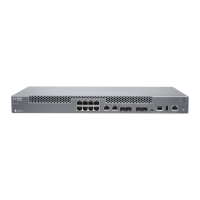CAUTION: Do not bend fiber-optic cables beyond their minimum bend
radius.Bending the cablesbeyond theirminimum bend radius candamage
the cables and cause problems that are difficult to diagnose.
3. Remove the cable connected to the transceiver (see “Disconnecting a Fiber-Optic
Cable from an MX150” on page 106). Cover the transceiver and the end of each
fiber-optic cable connector with a rubber safety cap immediately after disconnecting
the fiber-optic cables.
4. Using your fingers, pull the ejector lever away from the transceiver to unlock the
transceiver.
CAUTION: Before removing the transceiver, makesureyouopen the ejector
lever completely until you hear it click. Doing this prevents damage to the
transceiver.
5. Grasp the transceiver ejector lever and gently slide the transceiver approximately
0.5 in. (1.3 cm) straight out of the port (see Figure 21 on page 103).
CAUTION: To avoid electrostatic discharge (ESD) damage to the
transceiver, do not touch the connector pins at the end of the transceiver.
6. Using your fingers, grasp the body of the transceiver and pull it straight out of the port.
7. Place the transceiver in the electrostatic bag or on the antistatic mat placed on a flat,
stable surface.
8. Place the dust cover over the empty port.
Copyright © 2017, Juniper Networks, Inc.102
MX150 3D Universal Edge Router Hardware Guide

